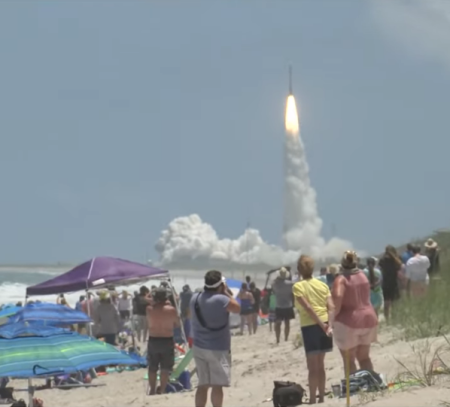Amazon picks rocket startup ABL to launch 1st two prototype Kuiper satellites
Capitalism in space: Amazon has chosen the smallsat startup rocket company ABL to launch its first two prototype Kuiper satellites, with that launch targeted for ’22.
KuiperSat-1 and KuiperSat-2 will reach orbit via the RS1, a new rocket developed by California-based ABL Space Systems. Amazon also announced today that it has signed a multi-launch deal with ABL to provide these early Project Kuiper launches.
The 88-foot-tall (27 meters) RS1 is capable of launching 2,975 pounds (1,350 kilograms) of payload to LEO, according to its ABL specifications page. ABL is charging $12 million for each launch of the two-stage rocket. The RS1 has not flown yet, but ABL has said that it aims to conduct a debut launch from Alaska’s Pacific Spaceport Complex before the end of 2021.
Earlier this year, Amazon announced that it had signed a deal with United Launch Alliance (ULA), whose Atlas V rocket will loft operational Project Kuiper craft on nine different launches.
Does anyone notice what rocket company has not won these contracts, even though its owner is also Amazon’s founder and biggest shareholder? That’s right, as far as I can tell, Blue Origin’s New Glenn rocket has apparently not won any contracts to launch Amazon’s Kuiper satellites. Notice also that the deal with ULA uses its Atlas-5 rocket, not its new Vulcan rocket, even though ULA wants Vulcan to replace the Atlas-5 beginning in ’22.
Since both New Glenn and Vulcan depend on Blue Origin’s troubled BE-4 rocket engine, these contracts strongly suggest that the engine’s technical problems have not yet been solved, and that neither rocket will be flying in ’22 as both companies have promised.
Capitalism in space: Amazon has chosen the smallsat startup rocket company ABL to launch its first two prototype Kuiper satellites, with that launch targeted for ’22.
KuiperSat-1 and KuiperSat-2 will reach orbit via the RS1, a new rocket developed by California-based ABL Space Systems. Amazon also announced today that it has signed a multi-launch deal with ABL to provide these early Project Kuiper launches.
The 88-foot-tall (27 meters) RS1 is capable of launching 2,975 pounds (1,350 kilograms) of payload to LEO, according to its ABL specifications page. ABL is charging $12 million for each launch of the two-stage rocket. The RS1 has not flown yet, but ABL has said that it aims to conduct a debut launch from Alaska’s Pacific Spaceport Complex before the end of 2021.
Earlier this year, Amazon announced that it had signed a deal with United Launch Alliance (ULA), whose Atlas V rocket will loft operational Project Kuiper craft on nine different launches.
Does anyone notice what rocket company has not won these contracts, even though its owner is also Amazon’s founder and biggest shareholder? That’s right, as far as I can tell, Blue Origin’s New Glenn rocket has apparently not won any contracts to launch Amazon’s Kuiper satellites. Notice also that the deal with ULA uses its Atlas-5 rocket, not its new Vulcan rocket, even though ULA wants Vulcan to replace the Atlas-5 beginning in ’22.
Since both New Glenn and Vulcan depend on Blue Origin’s troubled BE-4 rocket engine, these contracts strongly suggest that the engine’s technical problems have not yet been solved, and that neither rocket will be flying in ’22 as both companies have promised.


